Potential Contribution of the Grey Wolf Optimization Algorithm in Reducing Active Power Losses in Electrical Power Systems
Abstract
1. Introduction
GWO as an Effective Metaheuristic Algorithm in Problem Optimization
| Algorithm 1 grey wolf optimization (GWO) |
| Set the algorithm parameters, including population size N, maximum number of iterations (max_iter), and control parameters α, β, and δ. Set t to 0. By using an opposition-based learning strategy, start the grey population Xi where i = 1, 2, …, N. Determine each individual’s fitness level. Xα = the best individual Xβ = the second best individual Xδ = the third best individual Do (t < max_iter) While for Every individual Update control parameter a first, then A and C. Update Xα, Xβ, and Xδ End while Return Xα |
2. GWO’s Contribution in Reducing Active Power Losses in the Generation Stage
GWO and Reduction in Active Energy Loss by Determining the Best Allocation of DGs
3. Minimizing Active Power Losses in Power Transmission Systems Using GWO
GWO in FACTS Devices
4. GWO’s Functions in the Distribution Network
GWO’s Contribution to Smart Distribution System Active Power Loss Reduction
5. Discussion
6. Conclusions
Author Contributions
Funding
Institutional Review Board Statement
Informed Consent Statement
Data Availability Statement
Acknowledgments
Conflicts of Interest
References
- Ahmadi, B.; Ceylan, O.; Ozdemir, A. Optimal allocation of multi-type distributed generators for minimization of power losses in distribution systems. In Proceedings of the 2019 20th International Conference on Intelligent System Application to Power Systems (ISAP), New Delhi, India, 10–14 December 2019; pp. 1–6. [Google Scholar]
- Porate, K.B.; Hills, D.; Thakre, K.L.; Bodhe, G.L. Voltage Stability Enhancement of Low Voltage Radial Distribution Network Using Static VAR Compensator: A Case Study. WSEAS Trans. Power Syst. 2009, 4, 32–41. [Google Scholar]
- El-Mahdy, A.; Megahid, M.; Seleym, A.; Swief, R.A.; Abdel-salam, T.S. Minimizing Losses on Distribution System by PV and Compensating Capacitors. J. Pet. Min. Eng. 2020, 22, 53–60. [Google Scholar] [CrossRef]
- Mousavi, S.H.; Janatifar, V.; Abdolahi, A.; Sarhangzadeh, M. Optimal Scheduling of Active Distribution Networks with High Penetration of Plug-in Electric vehicles and Renewables Using Grasshopper Optimization Algorithm. In Proceedings of the 2021 29th Iranian Conference on Electrical Engineering (ICEE), Tehran, Iran, 18–20 May 2021; pp. 313–317. [Google Scholar]
- Wei, Z.; Quan, Z.; Wu, J.; Li, Y.; Pou, J.; Zhong, H. Deep Deterministic Policy Gradient-DRL Enabled Multiphysics-Constrained Fast Charging of Lithium-Ion Battery. IEEE Trans. Ind. Electron. 2022, 69, 2588–2598. [Google Scholar] [CrossRef]
- Wu, J.; Wei, Z.; Li, W.; Wang, Y.; Li, Y.R.; Sauer, D.U. Battery Thermal- and Health-Constrained Energy Management for Hybrid Electric Bus Based on Soft Actor-Critic DRL Algorithm. IEEE Trans. Ind. Inform. 2021, 17, 3751–3761. [Google Scholar] [CrossRef]
- Wu, J.; Wei, Z.; Liu, K.; Quan, Z.; Li, Y.R. Battery-Involved Energy Management for Hybrid Electric Bus Based on Expert-Assistance Deep Deterministic Policy Gradient Algorithm. IEEE Trans. Veh. Technol. 2020, 69, 12786–12796. [Google Scholar] [CrossRef]
- Rosales Muñoz, A.A.; Grisales-Noreña, L.F.; Montano, J.J.; Montoya, O.D.; Giral-Ramírez, D.A. Optimal Power Dispatch of Distributed Generators in Direct Current Networks Using a Master–Slave Methodology That Combines the Salp Swarm Algorithm and the Successive Approximation Method. Electronics 2021, 10, 2837. [Google Scholar] [CrossRef]
- Bentouati, B.; Javaid, M.S.; Bouchekara, H.R.; El-Fergany, A.A. Optimizing performance attributes of electric power systems using chaotic salp swarm optimizer. Int. J. Manag. Sci. Eng. Manag. 2019, 15, 165–175. [Google Scholar] [CrossRef]
- Sakr, W.S.; El-Sehiemy, R.A.; Azmy, A.M. Efficient Reactive Power Management via Enhanced Differential Evolution Algorithm with Adaptive Penalty Factor. Int. J. Power Eng. Energy 2015, 6, 542–550. [Google Scholar]
- Galvan, E.; Mandal, P.; Haque, A.U.; Tseng, T. Optimal Placement of Intermittent Renewable Energy Resources and Energy Storage System in Smart Power Distribution Networks. Electr. Power Compon. Syst. 2017, 45, 1543–1553. [Google Scholar] [CrossRef]
- Sakr, W.S.; El-Sehiemy, R.A.; Azmy, A.M. Adaptive differential evolution algorithm for efficient reactive power management. Appl. Soft Comput. 2017, 53, 336–351. [Google Scholar] [CrossRef]
- Abdelwahed, M.A.; El-Saadany, E.F. Power Sharing Control Strategy of Multiterminal VSC-HVDC Transmission Systems Utilizing Adaptive Voltage Droop. IEEE Trans. Sustain. Energy 2017, 8, 605–615. [Google Scholar] [CrossRef]
- Fontenot, H.; Ayyagari, K.S.; Dong, B.; Gatsis, N.; Taha, A.F. Buildings-to-distribution-network integration for coordinated voltage regulation and building energy management via distributed resource flexibility. Sustain. Cities Soc. 2021, 69, 102832. [Google Scholar] [CrossRef]
- El-Azab, M.; Omran, W.A.; Mekhamer, S.F.; Talaat, H.E. Allocation of FACTS Devices Using a Probabilistic Multi-Objective Approach Incorporating Various Sources of Uncertainty and Dynamic Line Rating. IEEE Access 2020, 8, 167647–167664. [Google Scholar] [CrossRef]
- Nasef, A.F.; Khattab, H.A.E.-H.; Osheba, D. Optimal Planning of a Distribution Network in Egypt. ERJ. Eng. Res. J. 2021, 44, 355–363. [Google Scholar] [CrossRef]
- Esfahani, M.M.; Mohammed, O.A. Real-time distribution of en-route Electric Vehicles for optimal operation of unbalanced hybrid AC/DC microgrids. eTransportation 2019, 1, 100007. [Google Scholar] [CrossRef]
- Restrepo, M.; Cañizares, C.A.; Kazerani, M. Three-Stage Distribution Feeder Control Considering Four-Quadrant EV Chargers. IEEE Trans. Smart Grid 2018, 9, 3736–3747. [Google Scholar] [CrossRef]
- Tolba, M.A.; Diab, A.A.; Tulsky, V.N.; Abdelaziz, A.Y. VLCI approach for optimal capacitors allocation in distribution networks based on hybrid PSOGSA optimization algorithm. Neural Comput. Appl. 2019, 31, 3833–3850. [Google Scholar] [CrossRef]
- Singh, A.; Sood, B.Y.; Barnwal, C.A. Case studies on optimal location and sizing of renewable energy generators in distribution system. J. Renew. Sustain. Energy 2016, 8, 065301. [Google Scholar] [CrossRef]
- Smadi, I.A.; Albatran, S.A.; Ahmad, H.J. On the Performance Optimization of Two-Level Three-Phase Grid-Feeding Voltage-Source Inverters. Energies 2018, 11, 400. [Google Scholar] [CrossRef]
- Sushkov, V.V.; Antropova, V.R.; Losev, F.A.; Sukhachev, I.S. The Scheduling of the Alarm Limit Mode Energy Consumption Taking into Account the Ability of Oilfield Consumers to be Stable at Sudden Deficiency of Active Power in the Power System. In Proceedings of the 2020 Dynamics of Systems, Mechanisms and Machines (Dynamics), Omsk, Russia, 10–12 November 2020; pp. 1–6. [Google Scholar]
- Upadhyay, D.A.; Patel, C. Minimization of Active Power Losses and Voltage Improvement In Distribution Network. J. Emerg. Technol. Innov. Res. 2018, 5, 2349–5162. [Google Scholar]
- Bortoni, E.D.; Scabeni, L.; Ferreira, C.; Siniscalchi, R.T. Losses and maintenance cost distribution in shared transmission lines. In Proceedings of the 2019 IEEE Power & Energy Society General Meeting (PESGM), Atlanta, GA, USA, 4–8 August 2019; pp. 1–5. [Google Scholar]
- Khodr, H.M.; El-Araby, E.E.; Abdel-halim, M.A. Methodology for Minimizing Power Losses in Feeders of Large Distribution Systems Using Mixed Integer Linear Programming. J. Eng. Comput. Sci. 2014, 7, 157–199. [Google Scholar]
- Parmar, S.A.; Trivedi, I.N.; Bhesdadiya, R.H.; Jangir, P. Reactive and Active Power Losses Minimization using Human Behavior Based Optimization. In Proceedings of the AEPEE 2016, Morbi, India, 28–29 June 2016. [Google Scholar]
- Hota, P.K.; Naik, A.P. A New Methodology for Active Power Transmission Loss Allocation in Deregulated Power System. Int. J. Electr. Comput. Eng. 2017, 7, 1725–1737. [Google Scholar] [CrossRef]
- Abu Haggar, M.F.; Beshr, E.H.; Eteiba, M.B. Minimizing Power Loss in Distribution System by Optimal Sizing and Sitting of Distributed Generators with Network Reconfiguration Using Grey Wolf and Particle Swarm Optimizers. In Proceedings of the 2018 IEEE International Conference on Environment and Electrical Engineering and 2018 IEEE Industrial and Commercial Power Systems Europe (EEEIC/I&CPS Europe), Palermo, Italy, 12–15 June 2018; pp. 1–6. [Google Scholar]
- Rahmati, K.; Ebrahimi, R.; Darabad, V.P. Optimal Active Distribution Network Reconfiguration for Loss and Supply Cost Minimization Using Grey Wolf Algorithm. J. Appl. Dyn. Syst. Control. 2021, 3, 23–30. [Google Scholar]
- Hans, R.; Kaur, H. Opposition-Based Enhanced Grey Wolf Optimization Algorithm for Feature Selection in Breast Density Classification. Int. J. Mach. Learn. Comput. 2020, 10, 458–464. [Google Scholar] [CrossRef]
- Ebrahim, E.A.; Abou-Hashima, H.A.G. Particle Swarm Optimization-Based Control of Shunt Active- Power Filter with Both Static and Dynamic Loads. J. Electr. Eng. 2016, 16, 1–12. [Google Scholar]
- Boktor, C.G.; Youssef, A.; Kamel, S.; Ahmed, A. Optimal DG Allocation in Radial Distribution Networks Using a Combined Approach Consisting Particle Swarm optimization9 Grey Wolf optimizer and Loss Sensitivity Factor. In Proceedings of the 2019 21st International Middle East Power Systems Conference (MEPCON), Cairo, Egypt, 17–19 December 2019; pp. 1000–1005. [Google Scholar]
- Venkatesan, C.; Kannadasan, R.; Alsharif, M.H.; Kim, M.; Nebhen, J. A Novel Multiobjective Hybrid Technique for Siting and Sizing of Distributed Generation and Capacitor Banks in Radial Distribution Systems. Sustainability 2021, 13, 3308. [Google Scholar] [CrossRef]
- Nataraj, D.P.; Loganathan, R.; Veerasamy, M.; Reddy, V.D. Maximizing Power Loss Reduction in Radial Distribution Systems by Using Modified Gray Wolf Optimization. Int. J. Eng. Technol. Innov. 2019, 9, 327–343. [Google Scholar]
- Sharma, D.; Ali, S. A Novel Approach of DG Allocation using Grey Wolf Optimization and Particle Swarm Optimization. Int. J. Digit. Appl. Contemp. Res. 2018, 7, 1–6. [Google Scholar]
- Mohamed, M.A.; Mohammed, A.A.; Abd Elhamed, A.M.; Hessean, M.E. Optimal Allocation of Photovoltaic Based and DSTATCOM in a Distribution Network under Multi Load Levels. Eur. J. Eng. Res. Sci. 2019, 4, 114–119. [Google Scholar] [CrossRef]
- Abd El-salam, M.; Beshr, E.H.; Eteiba, M.B. A New Hybrid Technique for Minimizing Power Losses in a Distribution System by Optimal Sizing and Siting of Distributed Generators with Network Reconfiguration. Energies 2018, 11, 3351. [Google Scholar] [CrossRef]
- Sidea, D.O.; Picioroagă, I.I.; Bulac, C. Optimal Battery Energy Storage System Scheduling Based on Mutation-Improved Grey Wolf Optimizer Using GPU-Accelerated Load Flow in Active Distribution Networks. IEEE Access 2021, 9, 13922–13937. [Google Scholar] [CrossRef]
- Sultan, I.A.; Swief, R.A.; Mostafa, M.M. Optimal Dg Placement in a Radial Distribution Network For Reliability Improvement. J. Al-Azhar Univ. Eng. Sect. 2017, 12, 1351–1358. [Google Scholar] [CrossRef]
- Pal, A.; Chakraborty, A.K.; Bhowmik, A.R.; Bhattacharya, B. Optimal DG allocation for minimizing active power loss with better computational speed and high accuracy. In Proceedings of the 2018 4th International Conference on Recent Advances in Information Technology (RAIT), Dhanbad India, 15–17 March 2018; pp. 1–6. [Google Scholar]
- Sanjay, R.; Jayabarathi, T.; Raghunathan, T.; Ramesh, V.; Mithulananthan, N. Optimal Allocation of Distributed Generation Using Hybrid Grey Wolf Optimizer. IEEE Access 2017, 5, 14807–14818. [Google Scholar] [CrossRef]
- Boktor, C.G.; Youssef, A.; Kamel, S. Optimal Installation of Renewable DG Units in Distribution System Using Hybrid Optimization Technique. In Proceedings of the 2019 IEEE Conference on Power Electronics and Renewable Energy (CPERE), Aswan City, Egypt, 23–25 October 2019; pp. 129–134. [Google Scholar]
- Sayed, F.E.; Kamel, S.; Tostado, M.; Jurado, F. Congestion Management in Power System Based on Optimal Load Shedding Using Grey Wolf Optimizer. In Proceedings of the 2018 Twentieth International Middle East Power Systems Conference (MEPCON), Nasr City, Egypt, 18–20 December 2018; pp. 942–947. [Google Scholar]
- Apribowo, C.H.; Listiyanto, O. Analysis of Load Flow Method with Static Var Compensator (SVC) for Minimizing Transmission Losses in Power System: A Case Study of 500 KV Java-Bali Electrical Power System. J. Electr. Electron. Inf. Commun. Technol. 2019, 9–12. [Google Scholar] [CrossRef]
- Artemenko, M.; Mykhalskyi, V.; Shapoval, I. Active filtration theory of multiphase power supply sys tems aimed at minimizing the power loss in the transmission line. Rep. Natl. Acad. Sci. Ukr. 2020, 39–50. [Google Scholar] [CrossRef]
- Gautam, A.; Sharma, P.; Kumar, Y. Mitigating Congestion in Restructured Power System using FACTS Allocation by Sensitivity Factors and Parameter Optimized by GWO. Adv. Sci. Technol. Eng. Syst. J. 2020, 5, 1–10. [Google Scholar] [CrossRef]
- Nepomuceno, L.S.; de Paula, A.N.; de Oliveira, E.J. Planejamento da Transmissão via Meta-Heurística Híbrida. In Proceedings of the Simpósio Brasileiro de Sistemas Elétricos-SBSE, Santo André, Brazil, 25–28 August 2020. [Google Scholar]
- Moradi, M.; Badri, A.; Ghandehari, R. Non-convex constrained economic dispatch with valve point loading effect using a grey wolf optimizer algorithm. In Proceedings of the 2016 6th Conference on Thermal Power Plants (CTPP), Tehran, Iran, 19–20 January 2016; pp. 96–104. [Google Scholar]
- Shehata, A.A.; Refaat, A.; Korovkin, N.V. Optimal Allocation of FACTS Devices based on Multi-Objective Multi-Verse Optimizer Algorithm for Multi-Objective Power System Optimization Problems. In Proceedings of the 2020 International Multi-Conference on Industrial Engineering and Modern Technologies (FarEastCon), Vladivostok, Russia, 6–9 October 2020; pp. 1–7. [Google Scholar]
- Sunday, Y.S.; Ubeh, O.P.; Saidu, A.A.; Fahad, A. Grey wolf optimizer based optimal placement of multiple facts devices in the transmission system under dynamic loading system. J. Eng. Stud. Res. 2021, 27, 132–143. [Google Scholar] [CrossRef]
- Nayak, P.C.; Rath, S.; Prusty, R.C. Performance Analysis of different FACTS devices using Grey Wolf Optimization algorithm PDF plus (1+PI) controller based multi-area AGC system. In Proceedings of the 2020 International Conference on Renewable Energy Integration into Smart Grids: A Multidisciplinary Approach to Technology Modelling and Simulation (ICREISG), Piscataway, NJ, USA, 14–15 February 2020; pp. 143–148. [Google Scholar]
- Amin, A.R.; Kamel, S.; Ebeed, M. Optimal reactive power dispatch considering SSSC using Grey Wolf algorithm. In Proceedings of the 2016 Eighteenth International Middle East Power Systems Conference (MEPCON), Cairo, Egypt, 27–29 December 2016; pp. 780–785. [Google Scholar]
- Lakum, A.; Mahajan, V. Cost Effective Optimal Placement and Sizing of Active Power Filter Using Grey Wolf Optimization in Radial Distribution System. In Proceedings of the 2018 IEEE 8th Power India International Conference (PIICON), Kurukshetra, India, 10–12 December 2018; pp. 1–6. [Google Scholar]
- Xu, Y. Hybrid GWO and CS Algorithm for UPQC Positioning in the Power Distribution Network. JCMPS 2020, 3, 1–9. [Google Scholar]
- Shehata, A.A.; Korovkin, N.V.; Tolba, M.A.; Tulsky, V.N. Efficient Utilization of the Power Grid using FACTS devices based on a new Metaheuristic Optimizer. In Proceedings of the 2021 3rd International Youth Conference on Radio Electronics, Electrical and Power Engineering (REEPE), Moscow, Russia, 11–13 March 2021; pp. 1–7. [Google Scholar]
- Priya, J.L.; Christa, S.T. An Effective Hybridized GWO-BSA for Resolving Optimal Power Flow Problem with the Inclusion of UPFC. Solid State Technol. 2021, 63, 5153–5173. [Google Scholar]
- Hamour, H.; Kamel, S.; Nasrat, L.S.; Yu, J. Distribution Network Reconfiguration Using Augmented Grey Wolf Optimization Algorithm for Power Loss Minimization. In Proceedings of the 2019 International Conference on Innovative Trends in Computer Engineering (ITCE), Aswan, Egypt, 2–4 February 2019; pp. 450–454. [Google Scholar]
- Belbachir, N.; Zellagui, M.; Settoul, S.; El-Bayeh, C.Z.; Bekkouche, B. Simultaneous optimal integration of photovoltaic distributed generation and battery energy storage system in active distribution network using chaotic grey wolf optimization. Electr. Eng. Electromechanics 2020, 3, 52–61. [Google Scholar] [CrossRef]
- Zhang, X.; Yang, J.; Wang, W.; Jing, T.; Zhang, M. Optimal Operation Analysis of the Distribution Network Comprising a Micro Energy Grid Based on an Improved Grey Wolf Optimization Algorithm. Appl. Sci. 2018, 8, 923. [Google Scholar] [CrossRef]
- Singh, J.; Tiwari, R. Active and Reactive Power Management of EVs in Reconfigurable Distribution System. In Proceedings of the 2020 IEEE 9th Power India International Conference (PIICON), Sonepat, India, 28 February–1 March 2020; pp. 1–6. [Google Scholar]
- Moradi, A.; Alinejad-Beromi, Y.; Parsa, M.; Mohammadi, M. Optimal Locating and Sizing of Unified Power Quality Conditioner- phase Angle Control for Reactive Power Compensation in Radial Distribution Network with Wind Generation. Int. J. Eng. Trans. B Appl. 2017, 31, 299–306. [Google Scholar]
- Siavash, M.; Pfeifer, C.; Rahiminejad, A.; Vahidi, B. Reconfiguration of Smart Distribution Network in the Presence of Renewable DG’s Using GWO Algorithm. IOP Conf. Series Earth Environ. Sci. 2017, 83, 012003. [Google Scholar] [CrossRef]
- Sultana, B.; Mustafa, M.W. Impact of reconfiguration and demand response program considering electrical vehicles in smart distribution network. In Proceedings of the 3rd International Electrical Engineering Conference (IEEC 2018), Karachi, Pakistan, 9–10 February 2018. [Google Scholar]
- Pal, A.; Bhattacharya, A.; Chakraborty, A.K. Allocation of EV Fast Charging Station with V2G Facility in Distribution Network. In Proceedings of the 2019 8th International Conference on Power Systems (ICPS), Jaipur, India, 20–22 December 2019; pp. 1–6. [Google Scholar]
- Reddy, A.V.; Reddy, M.D.; Reddy, M.S. Network Reconfiguration of Distribution System for Loss Reduction Using GWO Algorithm. Int. J. Electr. Comput. Eng. 2017, 7, 3226–3234. [Google Scholar]
- Ramadan, H.S.; Helmi, A.M. Optimal reconfiguration for vulnerable radial smart grids under uncertain operating conditions. Comput. Electr. Eng. 2020, 93, 107310. [Google Scholar] [CrossRef]
- Naderipour, A.; Abdullah, A.; Marzbali, M.H.; Arabi Nowdeh, S. An improved corona-virus herd immunity optimizer algorithm for network reconfiguration based on fuzzy multi-criteria approach. Expert Syst. Appl. 2021, 187, 115914. [Google Scholar] [CrossRef]
- Hassan, A.S.; Sun, Y.; Wang, Z. Multi-objective for optimal placement and sizing DG units in reducing loss of power and enhancing voltage profile using BPSO-SLFA. Energy Rep. 2020, 6, 1581–1589. [Google Scholar] [CrossRef]
- Bilal, M.; Rizwan, M. Coordinated Optimal Planning of Electric Vehicle Charging Stations and Capacitors in Distribution Systems with Vehicle-to-Grid Facility; Research Square: Durham, NC, USA, 2021. [Google Scholar]
- Saravanan, S.; Rajan, D. Peak Load Management and Charging Cost Minimization Integrating Plug-In Electric Vehicles. J. Nat. Remedies 2020, 21, 80–83. [Google Scholar]
- Lakum, A.; Mahajan, V. Optimal placement and sizing of multiple active power filters for radial distribution system using grey wolf optimizer. In Proceedings of the 2017 7th International Conference on Power Systems (ICPS), Pune, India, 21–23 December 2017; pp. 562–567. [Google Scholar]
- Zellagui, M.; Belbachir, N.; Ziad El-Bayeh, C. Optimal Allocation of RDG in Distribution System Considering the Seasonal Uncertainties of Load Demand and Solar-Wind Generation Systems. In Proceedings of the IEEE EUROCON 2021–19th International Conference on Smart Technologies, Lviv, Ukraine, 6–8 July 2021; pp. 471–477. [Google Scholar]
- McDonald, L.; Storry, R.L.; Kane, A.; McNicol, F.; Ault, G.W.; Kockar, I.; Mcarthur, S.; Davidson, E.M.; Dolan, M.J. Minimisation of distribution network real power losses using a smart grid Active Network Management System. In Proceedings of the 45th International Universities Power Engineering Conference UPEC2010, Cardiff, Wales, 7–10 September 2021; pp. 1–6. [Google Scholar]
- Santos-Gonzalez, E.E.; Gutiérrez-Alcaraz, G. Day-ahead transactive market operations with smart distribution power systems. In Proceedings of the 2020 52nd North American Power Symposium (NAPS), Tempe, AZ, USA, 11–13 April 2021; pp. 1–6. [Google Scholar]
- Zebua, O.; Ginarsa, I.M. Optimal Reactive Power Dispatch untuk Meminimisasi Rugi-Rugi Daya Aktif pada Sistem Lampung Menggunakan Metode Grey-Wolf Optimizer (GWO). J. Nas. Tek. Elektro 2017, 6, 90–96. [Google Scholar] [CrossRef][Green Version]
- M’hamdi, B.; Teguar, M.; Tahar, B. Optimal DG Unit Placement and Sizing in Radial Distribution Network for Power Loss Minimization and Voltage Stability Enhancement. Period. Polytech. Electr. Eng. Comput. Sci. 2020, 64, 157–169. [Google Scholar] [CrossRef]
- Sultana, U.; Khairuddin, A.B.; Mokhtar, A.S.; Qazi, S.H.; Sultana, B. An optimization approach for minimizing energy losses of distribution systems based on distributed generation placement. J. Teknol. 2017, 79, 5574. [Google Scholar] [CrossRef][Green Version]
- Oliveira, D.Q.; Marujo, D.; Santos, M.V.; Bonatto, B.D.; Arango, H.; Zambroni de Souza, A.C.; Delboni, L.F.; Carvalho Filho, J.M.; Silveira, P.M.; Felber, L.A.; et al. Multiobjective voltage control in smart distribution power systems. In Proceedings of the 2015 IEEE PES Innovative Smart Grid Technologies Latin America (ISGT LATAM), Montevideo, Uruguay, 5–7 October 2015; pp. 7–12. [Google Scholar]
- Mancilla-David, F.; Angulo, A.; Street, A. Power Management in Active Distribution Systems Penetrated by Photovoltaic Inverters: A Data-Driven Robust Approach. IEEE Trans. Smart Grid 2020, 11, 2271–2280. [Google Scholar] [CrossRef]


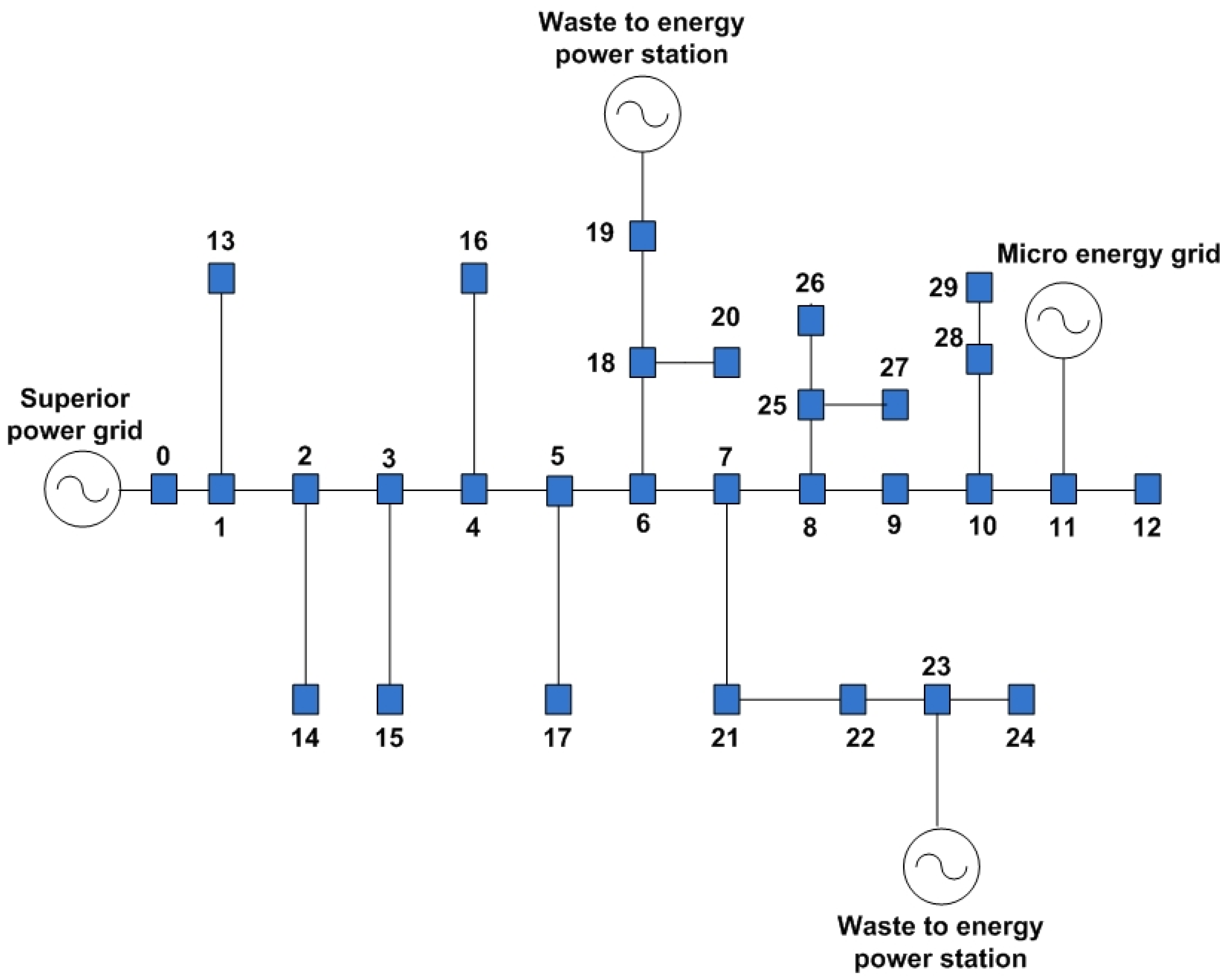
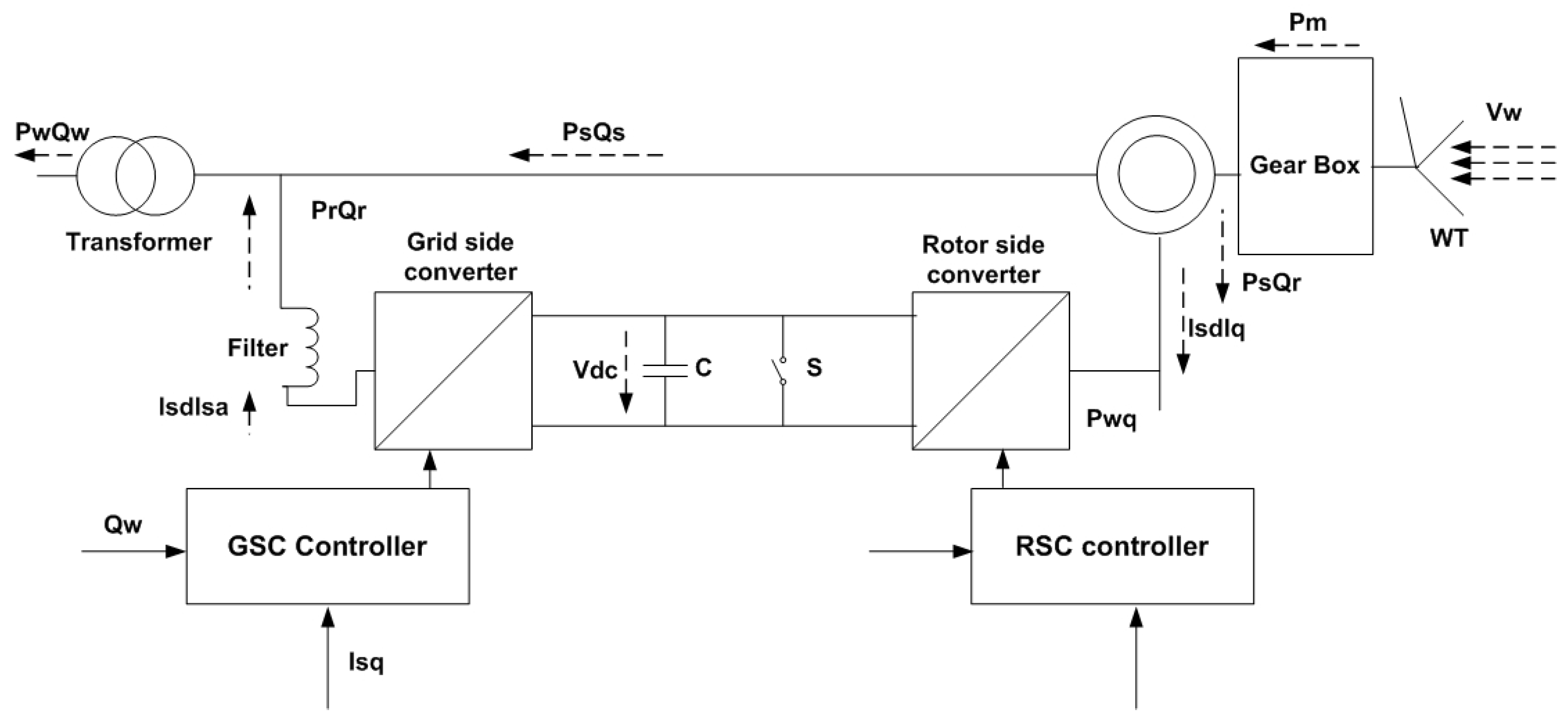

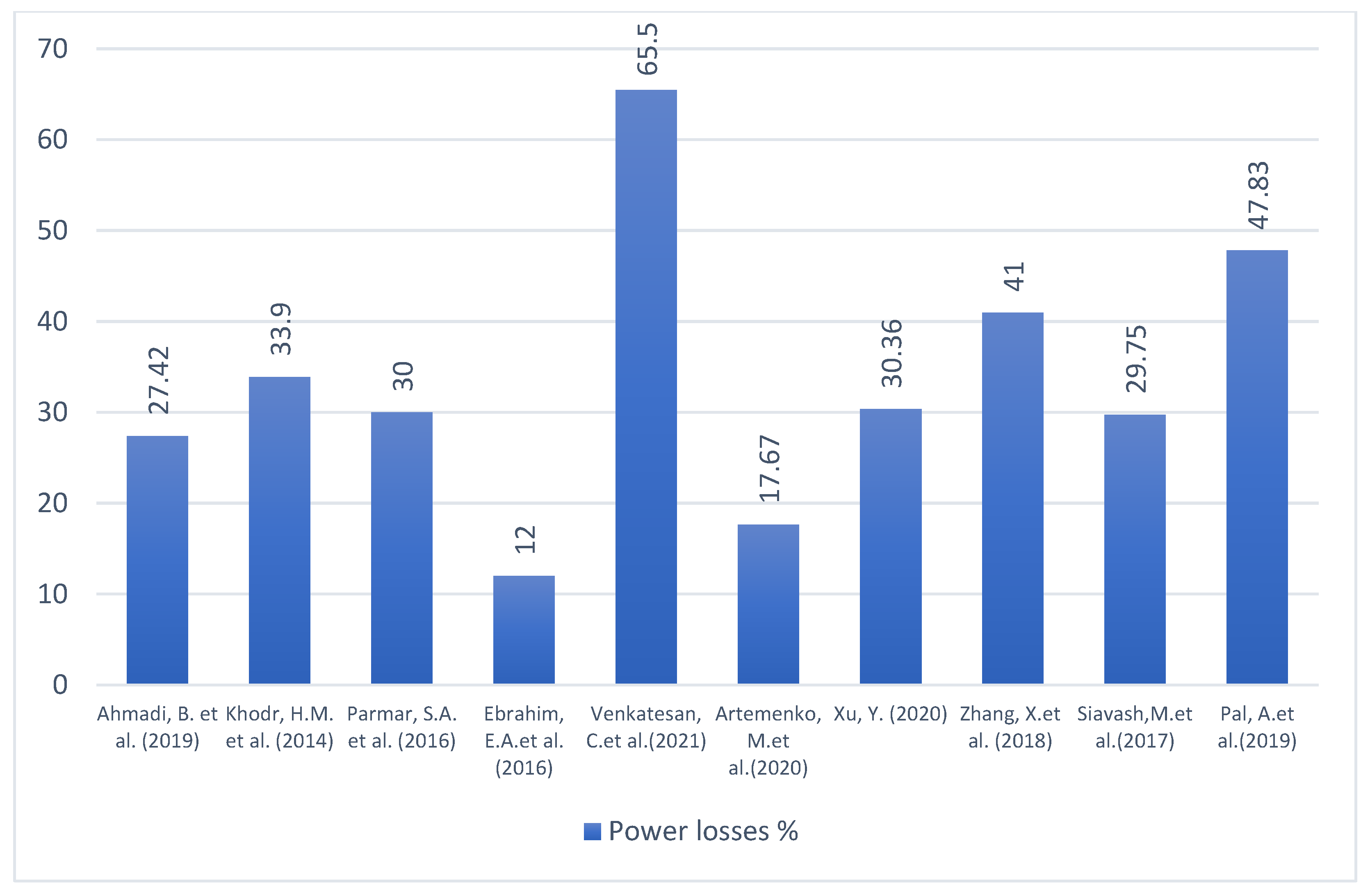
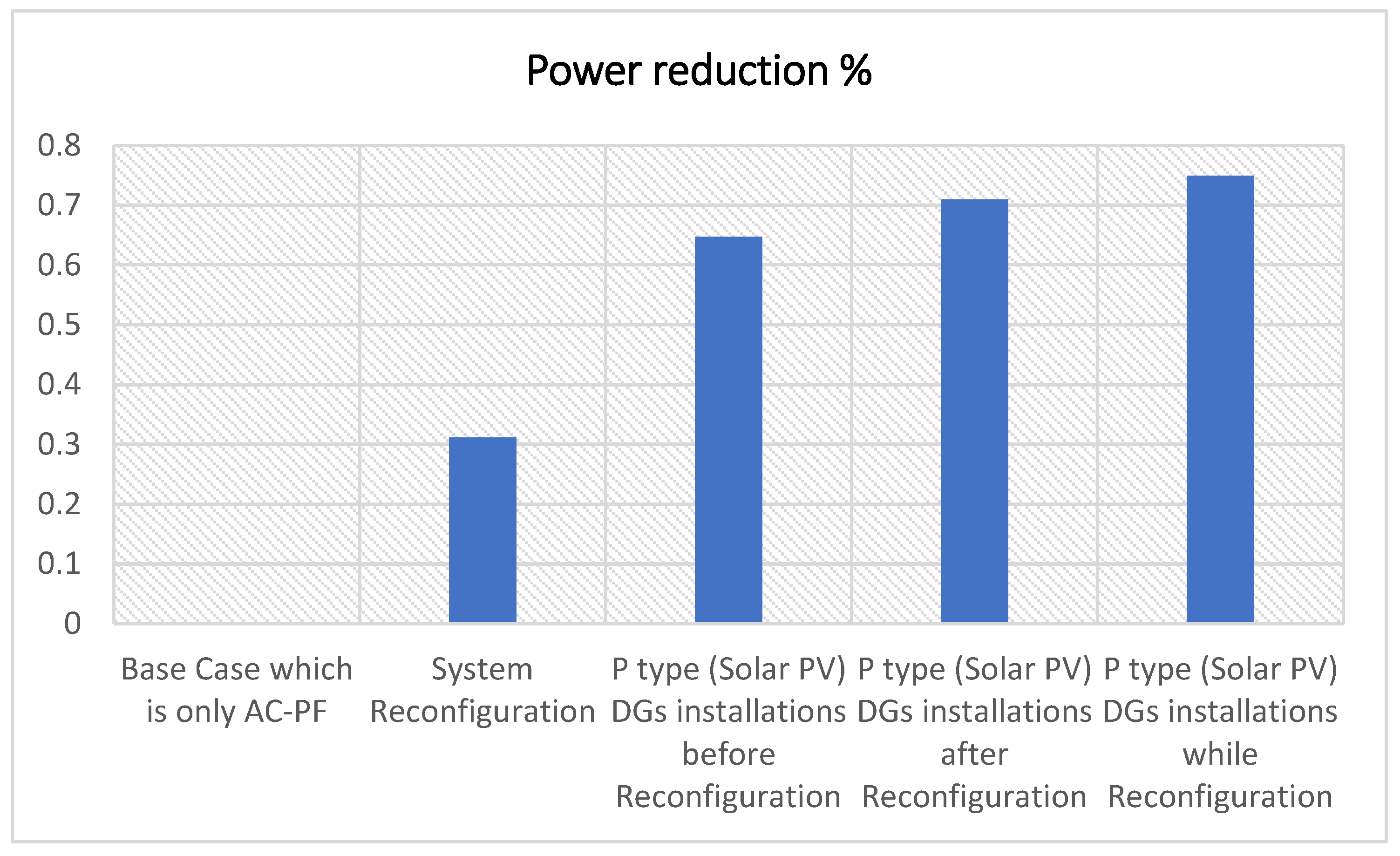
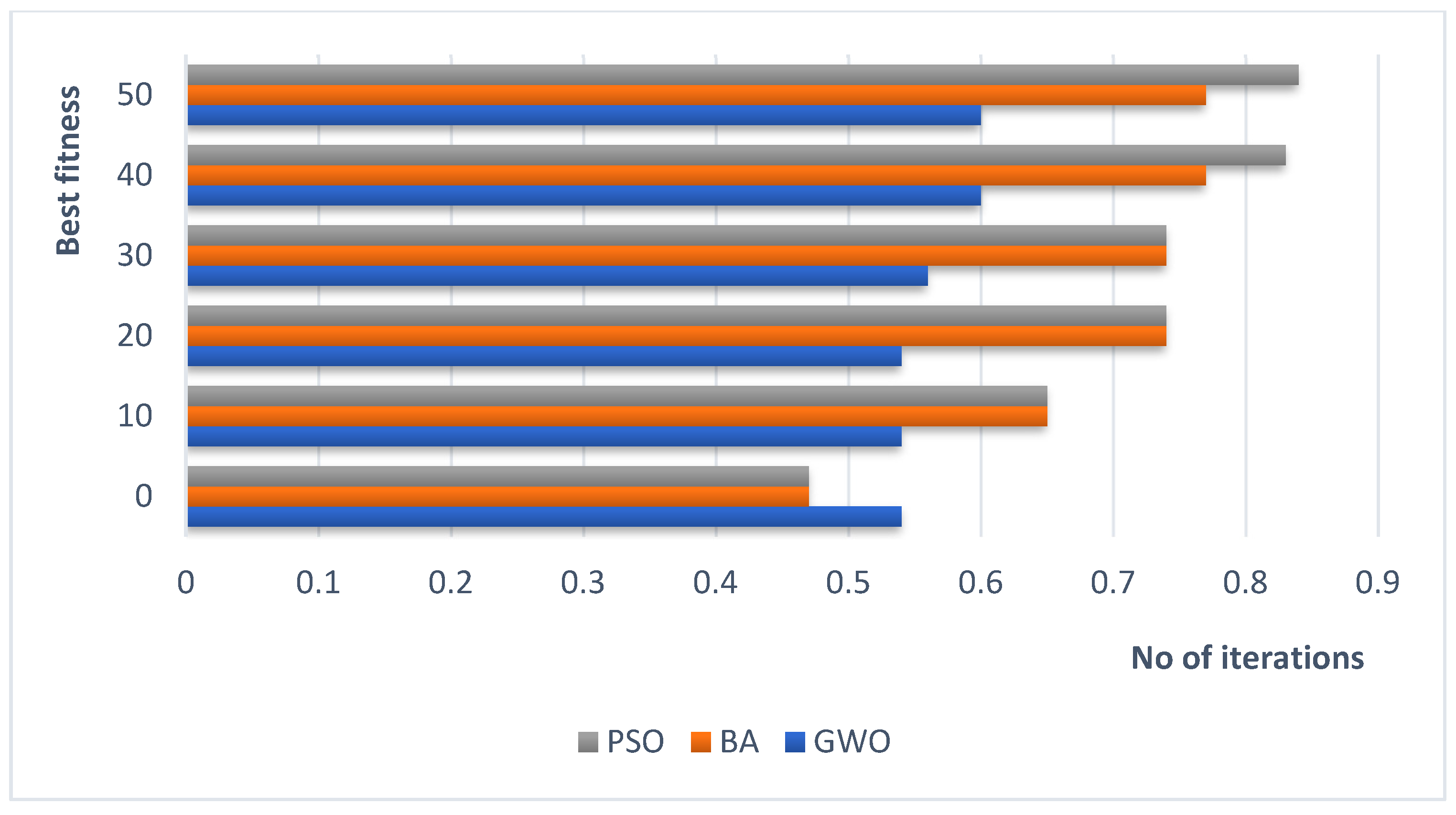
| Case | No of DGs | PV1 Site | PV2 Site | PV3 Site | PV4 Site |
|---|---|---|---|---|---|
| 1 | 1 | 13 | ----- | ----- | ----- |
| 2 | 1 | 31 | ----- | ----- | ----- |
| 3 | 2 | 31 | 14 | ----- | ----- |
| 4 | 2 | 31 | 25 | ----- | ----- |
| 5 | 2 | 6 | 19 | ----- | ----- |
| 6 | 3 | 25 | 7 | 17 | ----- |
| 7 | 3 | 32 | 7 | 11 | ----- |
| 8 | 4 | 4 | 3 | 30 | 11 |
| Case | No of DGs | PV1 Size (kW) | PV2 Size (kW) | PV3 Size (kW) | PV4 Size (kW) |
|---|---|---|---|---|---|
| 1 | 1 | 1000 | ----- | ----- | ----- |
| 2 | 1 | 1000 | ----- | ----- | ----- |
| 3 | 2 | 946 | 760 | ----- | ----- |
| 4 | 2 | 933 | 960 | ----- | ----- |
| 5 | 2 | 1000 | 439 | ----- | ----- |
| 6 | 3 | 959 | 1000 | 248 | ----- |
| 7 | 3 | 360 | 810 | 343 | ----- |
| 8 | 4 | 0 | 886 | 537 | 485 |
| Case | No of DGs | WT1 Site | WT2 Site | WT3 Site | WT4 Site |
|---|---|---|---|---|---|
| 1 | 1 | 29 | ----- | ----- | ----- |
| 2 | 2 | 6 | 14 | ----- | ----- |
| 3 | 1 | 6 | ----- | ----- | ----- |
| 4 | 2 | 14 | 6 | ----- | ----- |
| 5 | 3 | 14 | 30 | 24 | ----- |
| 6 | 2 | 30 | 13 | ----- | ----- |
| 7 | 3 | 24 | 14 | 30 | ----- |
| 8 | 4 | 25 | 7 | 31 | 15 |
| Case | No of DGs | WT1 Size (kW) | WT2 Size (kW) | WT3 Size (kW) | WT4 Size (kW) |
|---|---|---|---|---|---|
| 1 | 1 | 1000 | ----- | ----- | ----- |
| 2 | 2 | 1000 | 456 | ----- | ----- |
| 3 | 1 | 1000 | ----- | ----- | ----- |
| 4 | 2 | 441 | 1000 | ----- | ----- |
| 5 | 3 | 418 | 659 | 708 | ----- |
| 6 | 2 | 717 | 460 | ----- | ----- |
| 7 | 3 | 718 | 434 | 589 | ----- |
| 8 | 4 | 513 | 517 | 411 | 338 |
| Case | No of DGs | PV1 Site | PV2 Site | PV3 Site | PV4 Site |
|---|---|---|---|---|---|
| 1 | 1 | 62 | ----- | ----- | ----- |
| 2 | 1 | 11 | ----- | ----- | ----- |
| 3 | 2 | 17 | 62 | ----- | ----- |
| 4 | 2 | 62 | 11 | ----- | ----- |
| 5 | 2 | 16 | 62 | ----- | ----- |
| 6 | 3 | 2 | 62 | 12 | ----- |
| 7 | 3 | 16 | 62 | 24 | ----- |
| 8 | 4 | 50 | 62 | 11 | 21 |
| Case | No of DGs | PV1 Size (kW) | PV2 Size (kW) | PV3 Size (kW) | PV4 Size (kW) |
|---|---|---|---|---|---|
| 1 | 1 | 1000 | ----- | ----- | ----- |
| 2 | 1 | 1000 | ----- | ----- | ----- |
| 3 | 2 | 636 | 955 | ----- | ----- |
| 4 | 2 | 887 | 659 | ----- | ----- |
| 5 | 2 | 297 | 931 | ----- | ----- |
| 6 | 3 | 1000 | 904 | 569 | ----- |
| 7 | 3 | 297 | 931 | 0 | ----- |
| 8 | 4 | 868 | 895 | 325 | 188 |
| Case | No of DGs | WT1 Site | WT2 Site | WT3 Site | WT4 Site |
|---|---|---|---|---|---|
| 1 | 1 | 61 | ----- | ----- | ----- |
| 2 | 2 | 61 | 18 | ----- | ----- |
| 3 | 1 | 61 | ----- | ----- | ----- |
| 4 | 2 | 61 | 18 | ----- | ----- |
| 5 | 3 | 61 | 21 | 11 | ----- |
| 6 | 2 | 61 | 18 | ----- | ----- |
| 7 | 3 | 11 | 21 | 61 | ----- |
| 8 | 4 | 61 | 12 | 13 | 18 |
| Case | No of DGs | WT1 Size (kW) | WT2 Size (kW) | WT3 Size (kW) | WT4 Size (kW) |
|---|---|---|---|---|---|
| 1 | 1 | 1000 | ----- | ----- | ----- |
| 2 | 2 | 1000 | 329 | ----- | ----- |
| 3 | 1 | 1000 | ----- | ----- | ----- |
| 4 | 2 | 1000 | 321 | ----- | ----- |
| 5 | 3 | 978 | 189 | 342 | ----- |
| 6 | 2 | 1000 | 311 | ----- | ----- |
| 7 | 3 | 342 | 189 | 978 | ----- |
| 8 | 4 | 993 | 240 | 0 | 199 |
| GWO Contribution | Ratio of Reduction in Power Losses Using GWO % | Convergence Rate % | Ref |
|---|---|---|---|
| Maximum losses are 3.1 MW/h and lower losses are 2.25 MW/h. | 27.42 | 19.64 | [1] |
| Resolving network. Reconfiguration problems by optimizing the installation of various DG types. | 30 | 44.4 | [28] |
| Reduction in active power after three years with growth in load and optimal DG locations. | 33.9 | ---- | [34] |
| Power loss variation for one-year period. | 12 | ---- | [38] |
| As the number of DG units increases, the power loss reduces. For the GWO, the power loss reduces to 72.784 kW with an initial base case 210.98 kW for the 3 DG units. | 65.5 | 21 | [41] |
| There is a total harmonic distortion in voltage reduction using GWO. | 17.67 | 54.54 | [53] |
| GWO can reduce power loss from 130.07 (kW) in test system 1 to 90.6 (kW) in test system. | 30.36 | 16.6 | [61] |
| Power losses reduce to 141.82 kW with an initial base case 201.87 kW. | 29.75 | 5.4 | [69] |
| GWO can solve a constrained non-linear optimization problem of optimal placement and sizing of multiple active power filters. | 47.83 | 80 | [71] |
Publisher’s Note: MDPI stays neutral with regard to jurisdictional claims in published maps and institutional affiliations. |
© 2022 by the authors. Licensee MDPI, Basel, Switzerland. This article is an open access article distributed under the terms and conditions of the Creative Commons Attribution (CC BY) license (https://creativecommons.org/licenses/by/4.0/).
Share and Cite
Abbas, M.; Alshehri, M.A.; Barnawi, A.B. Potential Contribution of the Grey Wolf Optimization Algorithm in Reducing Active Power Losses in Electrical Power Systems. Appl. Sci. 2022, 12, 6177. https://doi.org/10.3390/app12126177
Abbas M, Alshehri MA, Barnawi AB. Potential Contribution of the Grey Wolf Optimization Algorithm in Reducing Active Power Losses in Electrical Power Systems. Applied Sciences. 2022; 12(12):6177. https://doi.org/10.3390/app12126177
Chicago/Turabian StyleAbbas, Mohamed, Mohammed A. Alshehri, and Abdulwasa Bakr Barnawi. 2022. "Potential Contribution of the Grey Wolf Optimization Algorithm in Reducing Active Power Losses in Electrical Power Systems" Applied Sciences 12, no. 12: 6177. https://doi.org/10.3390/app12126177
APA StyleAbbas, M., Alshehri, M. A., & Barnawi, A. B. (2022). Potential Contribution of the Grey Wolf Optimization Algorithm in Reducing Active Power Losses in Electrical Power Systems. Applied Sciences, 12(12), 6177. https://doi.org/10.3390/app12126177






